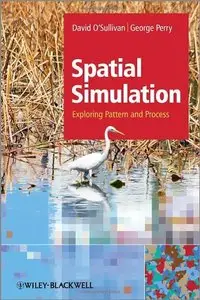David O'Sullivan, George L. W. Perry, "Spatial Simulation: Exploring Pattern and Process"
English | ISBN: 1119970792, 1119970806 | 2013 | EPUB | 330 pages | 19 MB
English | ISBN: 1119970792, 1119970806 | 2013 | EPUB | 330 pages | 19 MB
A ground-up approach to explaining dynamic spatialmodelling for an interdisciplinary audience.
Across broad areas of the environmental and social sciences,simulation models are an important way to study systemsinaccessible to scientific experimental and observational methods,and also an essential complement to those more conventionalapproaches. The contemporary research literature is teemingwith abstract simulation models whose presentation ismathematically demanding and requires a high level of knowledge ofquantitative and computational methods and approaches. Furthermore, simulation models designed to represent specificsystems and phenomena are often complicated, and, as a result,difficult to reconstruct from their descriptions in theliterature. This book aims to provide a practical andaccessible account of dynamic spatial modelling, while alsoequipping readers with a sound conceptual foundation in thesubject, and a useful introduction to the wide-rangingliterature.
Spatial Simulation: Exploring Pattern and Process isorganised around the idea that a small number of spatial processesunderlie the wide variety of dynamic spatial models. Its centralfocus on three building-blocks of dynamic spatialmodels forces of attraction and segregation, individualmobile entities, and processes of spread guides the readerto an understanding of the basis of many of the complicated modelsfound in the research literature. The three building block modelsare presented in their simplest form and are progressivelyelaborated and related to real world process that can berepresented using them. Introductory chapters cover essentialbackground topics, particularly the relationships between pattern,process and spatiotemporal scale. Additional chaptersconsider how time and space can be represented in more complicatedmodels, and methods for the analysis and evaluation of models.Finally, the three building block models are woven together in amore elaborate example to show how a complicated model can beassembled from relatively simple components.
To aid understanding, more than 50 specific models described inthe book are available online at patternandprocess.org forexploration in the freely available Netlogo platform. Thisbook encourages readers to develop intuition for the abstract typesof model that are likely to be appropriate for application in anyspecific context. Spatial Simulation: Exploring Patternand Process will be of interest to undergraduate and graduatestudents taking courses in environmental, social, ecological andgeographical disciplines. Researchers and professionals whorequire a non-specialist introduction will also find this book aninvaluable guide to dynamic spatial simulation.



